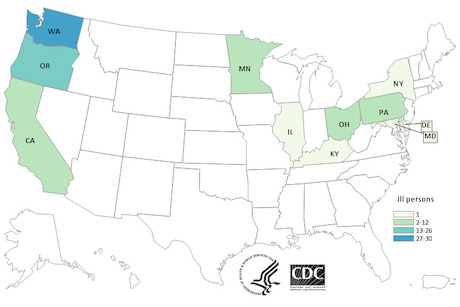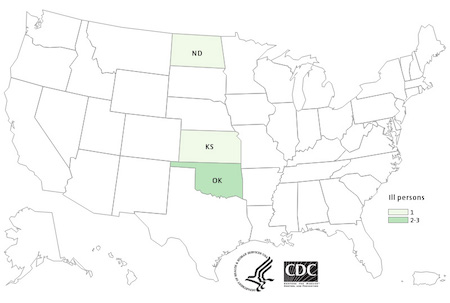The Centers for Disease Control and Prevention (CDC) has declared the two outbreaks of E. coli O26 infections linked to Chipotle Mexican Grill restaurants over. The most recent illness reported started two months ago, on December 1, 2015. At least 60 people in 14 states were sickened in this outbreak. There were no deaths, and 22 people were hospitalized.

The first outbreak, which sickened at least 55 people, was detected by officials in Washington and Oregon in late October 2015, and gradually spread to other states around the country. The final case count by state for the larger outbreak is: California (3), Delaware (1), Illinois (1), Kentucky (1), Maryland (1), Minnesota (2), New York (1), Ohio (3), Oregon (13), Pennsylvania (2), and Washington (27). The illnesses in this outbreak ranged from October 19, 2015 to December 1, 2015. Fifty-seven percent of ill persons were female.

The second outbreak, which infected five people in three states, was from a different, rare strain of E. coli O26. The case count for that outbreak is: Kansas (1), North Dakota (1), and Oklahoma (3). Illnesses in this outbreak started on dates ranging from November 18, 2015 to November 26, 2015. Eighty percent of ill persons in this outbreak were female.
The PulseNet database discovered two different, rare DNA fingerprints of Shiga toxin-producing E. coli O26 (STEC O26), and whole genome sequencing (WSG) revealed more detailed information about the DNA of those two bacterial strains. After interviewing people who were sickened, public health officials determined that the illness was linked to eating at multiple Chipotle Mexican grill locations.
The bacteria in the larger outbreak was “highly related genetically” in all 36 people tested. The bacteria in the second, smaller outbreak was “highly related genetically” to the four people tested, but were not related to the isolates from ill persons in the first outbreak.
Testing of multiple food items collected from Chipotle restaurant locations did not identify STEC O26, but that does not mean the outbreak is not linked to those restaurants. The evidence may have been eaten or thrown away long before investigators collected food from the facilities. Most of the ill people in these outbreaks ate many of the same food items at a Chipotle restaurant. When a restaurant serves foods with several ingredients that are mixed or cooked together and then used in multiple foods, it can be more difficult for epidemiologic studies to find the specific ingredient that is contaminated with the pathogenic bacteria.
The symptoms of an E. coli infection include severe stomach and abdominal cramps, watery and/ or bloody diarrhea, a mild fever, and nausea or vomiting. Symptoms usually begin three to four days after exposure to the bacteria. Most people get better without medical treatment, but some become so ill they must be hospitalized for dehydration or other complications. If these infections are not properly treated, they can develop into hemolytic uremic syndrome (HUS), a serious illness that can cause kidney failure. There were no reports of HUS in either of these outbreaks.




